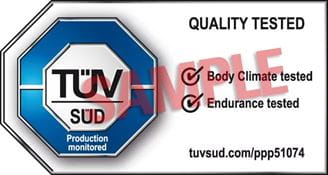
Adding value with our service portfolio
Adding value with our service portfolio


The certification mark applies for mattresses relating to different attributs like body climate, durability and lying characteristics.
The test mark is awarded within the framework of voluntary testing and certification. The test procedure developed by TÜV SÜD is based on numerous standards such as DIN EN 1957, Regulation (EC) No. 1907/2006 (REACH Regulation on the Registration, Evaluation, Authorization and Restriction of Chemicals), Regulation (EC) No. 850/2004 of the European Parliament and of the Council on persistent organic pollutants and Regulation (EU) No. 528/2012 on the placing on the market and use of biocidal products. The quality is assessed by means of industrial anthropological findings.
With the help of this special test, it is possible to assess whether the material properties of the mattress are changed by human body weight, heat and sweat. Following the continuous load test, the change in height and hardness is measured according to DIN EN 1957.
In addition, sinking depth and resulting angular ratios of a subject is measured when the mattress is new. The subject lies on his back and in the lateral position. The results are compared with the subject’s photogrammetric spine shape.
In addition, temperature and relative humidity are measured in the contact area between the mattress and the subject in supine position in his lumbar region via a sensor.
The tests are based on DIN EN 1957, which prescribes 30,000 mechanical test cycles to test the mechanical durability. In addition, the expected use can also be simulated in a period of at least ten years or 60,000 walking cycles. For this purpose, a roller is rolled over the mattress in accordance with DIN EN 1957 to simulate the rolling movements of a person. This test determines the extent to which the height, hardness and suspension of the mattress changes. After the test, experts from TÜV SÜD Product Service assess the signs of wear and tear.
In addition, the sinking depth and the resulting angular ratio of a subject are measured and evaluated from an industrial anthropological point of view. The results from the back and lateral position are again compared with the subject’s photogrammetric spine shape.
Furthermore, the contact area between human and mattress is determined. The contact surface is measured with a subject in supine position which lies with slightly spread legs and arms on the mattress. The contact surface should be neither too large nor too small for a good hold. The pressure distribution is then measured with the help of a subject on a pressure measuring mat.
In addition, the resistance to change position is measured with a roller described in DIN EN 1957, which is guided across the mattress with a vertical force at an even speed. The required horizontal force is measured.
Before and after the endurance test, TÜV SÜD Product Service's experts evaluate the sinking depth and the resulting angle ratios of various test persons with the special body shapes “pear” (A-shape) and “rectangular” (H-shape). The results from supine and lateral posture are compared with the subjects’ photogrammetric recorded spinal shape.
In addition, the epaulettes effect is tested. This describes the ventral flexion of the shoulder region in supine position. The sinking depth and the resulting angle ratios of the subjects are measured in the pectoral girdle area.
In addition, the point elasticity, which describes the maximum indentation depth of the user’s shoulder and pelvis, is tested. For this purpose, two dome-shaped test stamps are pressed into the mattress at a certain distance. The difference between the indentation values of the test pistons and the unloaded intermediate range results in the value of the point elasticity.
The stabilizing property is also tested. This describes the oscillation behavior as the user lies down or rotates.
For this purpose, a hemispherical test weight is dropped. The vibrations in the mattress are recorded with the help of a displacement sensor. The testers evaluate frequency, amplitude and number of oscillations.
The zone classification described by the manufacturer is checked. The hardness is determined by the length of the mattress. For this purpose, a dome-shaped pressure stamp is pressed into the mattress along the middle line.
The mattress cover is washed three times according to the manufacturer’s instructions and then pulled back onto the mattress.
The dimensional stability, color changes, shifting resistance of the fabric and other abnormalities are assessed.
Periodic surveillance and/or monitoring of the manufacture of a product constitutes the basic premise for certification that includes the award of a certification mark. Certification always requires product testing and regular factory inspections.
As a third-party expert organisation, TÜV SÜD Product Service verifies that the manufacturer is able to maintain consistent quality in line with the requirements throughout high-volume production and has established the necessary quality system, including incoming goods inspections, lists of materials and final product testing.
In addition, calibration of the necessary measuring and monitoring equipment must be ensured. Surveillance and/or monitoring covers the testing of safety-critical components and other materials used. If unauthorised changes are made to the product, the certificate will become invalid and the TÜV SÜD certification mark may no longer be used.
Site Selector
Global
Americas
Asia
Europe
Middle East and Africa